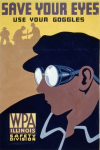
The image above is of the first atomic clock, constructed in 1949 by the US National Bureau of Standards (click on it for a larger version of the image).
The caption for this photograph reads:
[NBS Director] Dr. [Edward] Condon and Dr. Harold Lyons with the first atomic clock. It operated with an ammonia-regulated quartz crystal and ran with a constancy of one part in 20 million.
The Bureau atomic clock program sought to provide a spectroscopic standard capable of being used as a new atomic standard of time and frequency to replace the mean solar day and so change the arbitrary units of time to atomic ones. With such a clock, new precise values might be found for the velocity of light; new measurements of the rotation of the earth would provide a new tool for geophysicists; and new measurments of the mean sidereal year might test whether Newtonian and atomic time are the same, yielding important results for relativity theory and cosmology. [p. 476]
The text concerning this photo evolves out of a discussion of the NBS Central Radio Propagation Laboratory (CRPL):
[p. 475] CRPL's extension of the primary frequency standard to 40,000 megacycles in 1948 helped to open research in a field of physical science first explored during the war [World War II], that of microwave spectroscopy. Of immediate importance to the Bureau work on guided missiles, the new methods devised for measuring electrical quantities at microwave frequencies made possible the use of sharp microwave beams on systems where high resolution was needed, as in short range target-seeking rockets and missiles.131 [Original footnote 131: "NBS Annual Report 1948, p. xiv."]
[p. 476] The new microwave measurement techniques, by overcoming the limitations of conventional optical and infrared equipment, also promised to extend spectroscopic analysis methods to high polymer research, that is, to the investigation of substances such as paper, leather, and plastics which are made up of very large molecules.132 [Original footnote 132: "NBS Annual Report 1948, pp. xiv, 249."] An immediate and dramatic application of the microwave technique, however, was in the Bureau's construction of an atomic clock.
[p. 477] Some of the first microwave measurements of the spectrum lines of ammonia gas against the NBS primary frequency standard suggested that they might serve as an invariable secondary frequency standard. A year later, in 1949, the Bureau devised means for utilizing the vibrations of atoms in the ammonia molecule, derived from the microwave region of the ammonia gas, to control an oscillator with which to drive a clock.
The result was the first atomic clock ever built. While its magnitude of accuracy was only a little better than that of the 24-hour rotation of the earth, and not as good as time based on the annual rotation of the earth around the sun, a breakthrough had been achieved. With further refinement, using the cesium rather than ammonia atom, and with precise control of the radio frequency, much higher accuracy became possible. A time accuracy of at least one part in 10 billion, representing an error of 1 second in 300 years, was thus achieved, without reference to the earth's rotation or the planetary motions.133 Such timing is not possible with the 2,000-year old solar time system. And on an earth gradually slowing down, millionths of a second become vital in projecting such feats as timing rocket launches to meet in orbit hundreds of miles above the earth where a space platform might be assembled. [Original footnote 133: 'H. Lyons. "Microwave spectroscopy frequency and time standards," Elec. Eng 68, 251 (1949); NBS Annual Report 1951, pp. 13-14; H. Lyons, "Atomic clocks," Sci. Am 196, 71 (1957). The achievement represented an outgrowth of work started at Westinghouse by Dr. Condon. See William E. Good, "The inversion spectrum of ammonia," Phys. Rev. 69, 539 (1946).']
Of special importance to astronomy, both the clock and the method of construction represented new tools of research in technical fields where precise measurement of time and frequency are crucial, from long-rande radio navigation systems and tracking of satellites to basic research in microwave spectroscopy and in molecular structures.134 [Original footnote 134: "With continued refinement of the cesium atomic beam apparatus, the accuracy of time measurements increased to one part in 100 billion, or 200 times greater than that achieved by astronomical means. Subsequent use of atomic hydrogen masers promised to increase the order of accuracy still further. Meanwhile, on Oct. 8, 1964, the 12th General Conference of Weights and Measures, meeting in Paris, authorized a temporary atomic definition of the second, derived from the cesium clock, as the international unit of time. NBS TNB 48, 209 (1964)."]
Source:
Cochrane, Rexmond D. Measures for Progress: A History of the National Bureau of Standards. Washington, D.C.: U.S. Department of Commerce - National Bureau of Standards, 1966. US Library of Congress Catalog Card Number: 65-62472. Photo and caption p. 476, other text p. 475-477.
The work by Cochrane was an official US federal government
publication, and therefore is in the public domain.
The reprint of it here is dedicated to the
Public Domain.
Important disclaimers of warranty
and liability in the presentation of public domain material.
The rest of this page is
copyright © 2004 by David M. MacMillan.
This work is licensed under a
Creative Commons License,
which includes important disclaimers of warranty and liability.
lemur.com is a service mark of
David M. MacMillan
and Rollande Krandall.
The lemur image used below on this page is, however, in the
Public Domain
and is not claimed as a trade or service mark.
Other trademark
recognition.
Presented originally by lemur.com.SM
 A Gallery of Antiquarian Technology
[about this image]
A Gallery of Antiquarian Technology
[about this image]
 lemur.comSM
[about this image]
lemur.comSM
[about this image]